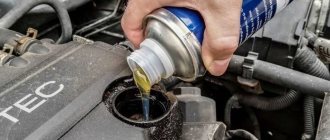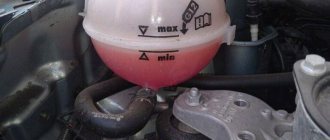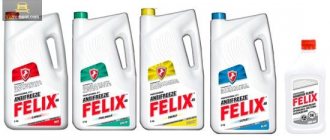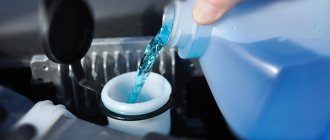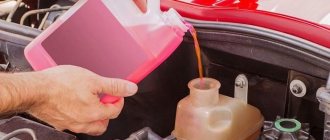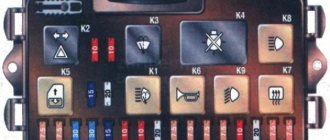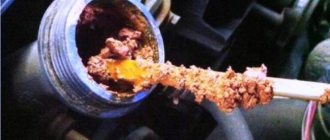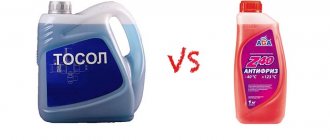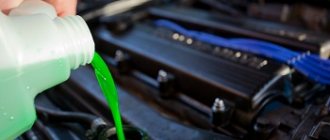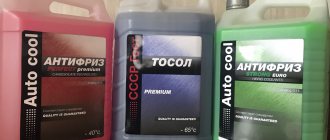Is it possible to mix antifreeze with antifreeze in a car’s cooling system? This is a fairly common question among novice motorists. The presence of the required volume of coolant in the system is a necessary condition for the safe and smooth operation of any power unit. This is especially important in winter, when the air temperature drops below zero and under such operating conditions the load on the unit increases significantly.
In the recent past, most motorists used a special liquid - antifreeze - to cool the engine. Today, most cars use antifreeze. Not long ago, debates began to arise on various forums about whether it was possible to mix these two types of liquids. Some car owners even have the opinion that if you mix the two above-mentioned substances, you will end up with a cooling mixture with increased technical capabilities. To find the truth in this matter, it is necessary to study all its components.
Differences between antifreeze and antifreeze
Three types of liquids can be used to cool the engine:
- Water is the very first type of coolant. Use only distilled or purified. FOR obvious reasons, modern cars have abandoned water;
- Antifreeze is a product of the Soviet chemical industry. Created as an alternative to foreign coolants. Initially it had a mineral composition and was poured into the cooling system of an internal combustion engine made of cast iron. The advent of engines made of light alloy materials forced manufacturers to change the composition - additives that caused corrosion of parts were eliminated. The composition has become organic;
- antifreeze (antifreeze - “anti-freeze”) is a foreign analogue of domestic coolant.
Antifreeze and antifreeze have different compositions and performance characteristics. Sometimes they are mixed in an attempt to obtain an enriched composition. But the result of a chemical reaction can be a substance that will disrupt the operation of the main components and assemblies of the car. Then you will need to flush the system and replace expensive components (for example, a clogged radiator).
Differences in composition
Antifreeze was created back in the 70s of the last century. Since then, additional additives have been introduced into the composition, but it has not changed significantly.
| Liquid/ Characteristic | Antifreeze blue | Green antifreeze | G11 | G12 | G13 |
| Composition (main substance – from 90%) | Ethylene | Ethylene | Ethylene | Ethylene | Propylene glycol+glycerin |
| Additive type | Anti-corrosion based on inorganic substances | Anti-corrosion based on inorganic substances | Organics – carbonates, copper corrosion agents, anti-foaming agents | Complex of organics, inorganic substances, anti-foaming. | Carbonates + silicates (less than 10%) + mineral particles, anti-foam, rust converters. |
| Boiling temperature | 110-115 C0 | 110-115 C0 | 110-115 C0 | 125-200 С0 | 120-200 С0 |
| Crystallization temperature | – 40 C0 | -65 C0 | -30 C0 | -40 to -60 C0 | from -40 to – 65 C0 |
Different colors of coolant are needed so that it can be distinguished from water at first glance.
Initially, the composition is transparent, so dyes are added to it so that there is no possibility of confusion with the distillate. The latter cannot be used at sub-zero temperatures.
Another reason for coloring antifreeze and antifreeze in bright shades is the ability for the motorist to determine the location of the leak if the liquid quickly leaves the system.
By characteristics
Both fluids under consideration have the same purpose - to prevent the engine from overheating and the coolant from freezing at sub-zero temperatures.
Important: if environmental issues are important to a motorist, you should give preference to antifreeze. Antifreeze was created more than 40 years ago. Even its modern composition, which is based on aggressive ethylene glycol, has a negative impact on the environment.
The main differences in performance characteristics can be identified:
- antifreeze is superior to antifreeze in terms of boiling and crystallization;
- additives in antifreeze more effectively protect the internal combustion engine by destroying rust;
- antifreeze does not create a thick protective film on surfaces, which allows it to more effectively protect the internal combustion engine from overheating;
- The service life of the foreign analogue is higher than that of antifreeze;
- antifreeze prevents the formation of air bubbles in the internal combustion engine liners (cavitation), extends the life of the water pump;
- The absence or small percentage of silicates in antifreeze prevents the formation of sediment in the form of silica sand, which clogs the radiator pipes and pipes.
Additives used
All additives used in cooling fluids can be divided into 3 categories.
- Protective additives
. Create a protective film on the internal surfaces of the entire cooling system. Mainly used in G11; - Anti-corrosion additives
. Necessary to combat corrosion in the system. They do not create a film, but they block the formation of rust. Mostly supplements of organic origin. They are used in G12; - Hybrid
. This is a combination of two types of additives at the same time. Characteristic of G13.
As for antifreeze, similar additives can be used here. The difference is small, but still there.
Mix different brands of antifreeze
Antifreeze comes in three general varieties. For convenience, they are marked with a alphanumeric code and have different shades of color. All antifreezes are based on ethylene glycol or propylene glycol (about 90%), water (about 5%), the rest is additives. These are the main differences between the compositions.
Differences between G11, G12 and G13
| Characteristic | G11 | G12, G12+, G12++ | G13 |
| Compound | Silicate (closest to antifreeze) | Carboxylicate, Lobridny – carboxylates with a small percentage (5-8%) of inorganic components (silicates, phosphates) | Propylene glycol (with glycerin) |
| Technology | The principle of operation is the creation of a continuous protective film. It is needed to prevent the aggressive effect of ethylene glycol on the metal. | Ethylene glycol, which is aggressive to metal, is enriched with organic compounds. Does not create a continuous film on the entire surface of the cooled units. Protection is activated when rust is detected - pointwise, in a layer no more than 1 micron thick, additives transform rust and remove residues from the system. G12+, G12++ are hybrid compositions, where a combination of organic acids and mineral components is used as additives. This type of antifreeze simultaneously creates a thin protective film and provides additional protection in areas of corrosion. | The base is propylene glycol. It is environmentally friendly (ethylene glycol used in previous generations of formulations is poisonous and aggressive). Similar in action to G12+, G12++ |
| Color | Green, blue (options) | Red, yellow, bright orange | Purple (shades) |
| Life time | 2-3 years | 3-5 years (or more) | 5 or more years |
| Operating principle | Creation of a continuous protective film to prevent corrosion | Point impact – covering potential corrosion areas with the thinnest protective film (no more than 1 micron) | Point protection |
| Where is it used? | On older engine types. For example, cast iron. Not recommended for modern internal combustion engines made of light alloy metals | The most universal option, used on most engines | High power engines |
Interesting: innovation in the automotive antifreeze market - MultiFreeze (Sintec) . This is a hybrid composition with universal performance properties. Feature: the ability to adapt to “work” with any type of antifreeze. Neutral to any metals, rubber and plastic products. Tests in laboratories prove the effectiveness of the innovation.
How to mix antifreeze
Antifreeze mixing scheme
When adding antifreeze to the system, you should not focus on similar colors. Only the composition plays an important role.
Can be combined:
- G11 is combined with antifreeze, G11 and G12++ antifreeze. They have an almost identical composition, based on ethylene glycol. What the compositions have in common is an ethylene glycol base and silicates in additives;
- G12 can be mixed with G12, G12+, G12++. They have almost identical compositions; the differences may only lie in the additive complex.
Cannot be combined:
- G11 and G12. Despite the same base, the additives of these antifreezes have a fundamentally different composition (inorganic and organic acids), the opposite principle of action. The resulting film (G11) will reduce heat transfer and may clog the radiator pipes;
- G13 cannot be combined with any type of antifreeze. The basis of G13 is propylene. This is a different type of alcohol, which is what all additives are designed for.
Conclusion: a universal donor for all types of antifreeze is a composition marked G12++.
Consequences
Signs of improper mixing of coolant types:
- engine overheating when the coolant level in the system is normal. If a breakdown occurs after adding antifreeze, a precipitate may have formed as a result of a chemical reaction. He clogged the cooling system and radiator pipes;
- antifreeze foaming. The liquid will begin to actively foam and boil away from the expansion tank.
Important: such consequences can also arise when adding a compound that is considered universal (G12++) to the system. This is possible if the liquids have different manufacturers. They use different additives without disclosing the formula of their product.
If the listed symptoms appear, you need to contact a service center to flush the cooling system and fill it with antifreeze of a homogeneous composition. You can do this yourself.
Foaming of antifreeze as a result of improper mixing of liquids - flushing the system is necessary
Additives used
All additives used in cooling fluids can be divided into 3 categories.
- Protective additives
. Create a protective film on the internal surfaces of the entire cooling system. Mainly used in G11; - Anti-corrosion additives
. Necessary to combat corrosion in the system. They do not create a film, but they block the formation of rust. Mostly supplements of organic origin. They are used in G12; - Hybrid
. This is a combination of two types of additives at the same time. Characteristic of G13.
As for antifreeze, similar additives can be used here. The difference is small, but still there.
Mix antifreeze of different colors
Domestic refrigerant has long been the only available option for car owners. Yes, and it was cheaper. The liquid does not lose popularity; it is available in two versions that differ in color - blue (green) and red.
Differences between red and green antifreeze
All domestically produced coolants are classified according to letter markings:
- A – the composition is ready for immediate pouring into the car’s cooling system;
- M – enriched with modified additives;
- K – concentrate. Before pouring, it will need to be diluted in the proportions indicated on the packaging by the manufacturer.
The most important characteristic by which antifreeze is distinguished is its freezing point.
The blue (greenish) composition has different letter designations. But its freezing temperature is always 40 C.
Coolant grade A65 has a red It can freeze at extreme temperatures of -65 C, has a traditional composition, and is ready to be added to the system.
If on a plastic container with antifreeze there is only a GOST number, but there is no coolant designation (coolant) with a number code, this is a fake.
Is it possible to mix antifreeze of different colors?
It is forbidden. Mixing antifreezes of different colors will lead to ineffective cooling, narrowing of the internal diameter of the pipes due to silicon deposits, overheating of the engine and failure.
Consequences
The most common breakdown when mixing antifreeze of different shades is the formation of a sediment of small particles, which narrow the internal diameter of the system tubes and clog the radiator. The consequence is a decrease in the efficiency of the coolant, engine overheating. If you do not pay attention to the obvious signs - unstable operation of the power unit, an increase in operating temperature to unacceptable limits, you will have to replace parts.
Photo gallery
Photos of the consequences of mixing liquids of different compositions.
Contamination on the engine radiator cooling device
Cooling system channels before and after flushing
Scale on a car radiator
Mixing antifreeze and antifreeze with each other
Rules for safe mixing - antifreeze with antifreeze, antifreeze - only with antifreeze of the same brand that circulates in the system. In all other cases, the car owner acts at his own peril and risk.
Before topping up, be sure to check for leaks in the system.
Important: before inspecting the system, you must allow the engine to cool and level the car...
How to add fluid to the system:
- The car is rearranged so that the hood is slightly higher than the trunk. This will help the air displaced by the fluid escape from the system. With a small amount of additive, the machine can be left standing level.
- Open the neck of the expansion tank - carefully, slowly. It is important to use protective equipment - gloves, rags to cover the neck.
- Pour antifreeze or antifreeze in a thin stream. The rapid entry of a large volume of liquid will lead to the formation of an air lock, which is difficult to get rid of.
- Start the engine - run for no more than 5 minutes. During this time, the liquid will be distributed throughout the system.
- Level control - orientation to the F (full) or Max mark on the expansion tank. If the volume of liquid is insufficient, the procedure is repeated (point 4-5). The cycle is repeated until the level stabilizes.
- Screw on the expansion tank cap.
- Be sure to carry out cleaning - wipe with a rag all parts under the hood that could have gotten drops of antifreeze or antifreeze. They can corrode rubber, plastic and metal parts.
When is coolant replacement necessary?
The coolant renewal date is often written on your car's registration certificate. If this date is not there, you need to read the instructions directly for the substance itself. Mixing is necessary only in a desperate situation.
First, you need to flush the entire system and only then fill in new antifreeze or other product that you have chosen.
You should change the product not only when it becomes dirty. For example, cars in Japan are initially filled with red liquid, which freezes only at a temperature of -30 degrees. Consequently, in European countries, due to harsh winters, this liquid simply freezes and will have to be changed.
Is it possible to add water to antifreeze and antifreeze?
Water is the easiest way to bring the system level to the desired level. Both antifreeze and antifreeze contain water, so an additional portion will not cause harm. Adding distilled water will reduce the concentration of chemicals and increase the freezing point.
Adding water is possible:
- when a liquid boils and water evaporates. In this situation, the concentration of chemicals increases. Only distilled water is added to the system. The regular one won't do. This is a temporary measure. As soon as possible, replace the antifreeze or antifreeze with a new one;
- when purchasing concentrated antifreeze or antifreeze, dilute it in accordance with the manufacturer’s recommendations on the container.
You cannot add distillate to the system:
- with a large loss of antifreeze or antifreeze. The cause was most likely mechanical damage. The proportion of antifreeze in this case is too small; added water will significantly change its performance characteristics for the worse - freezing and boiling points;
- at sub-zero temperatures. Otherwise, the highly diluted liquid will quickly set in the system, which will lead to breakdowns. For example, one of the pipes will rupture and the expansion tank will crack.
Main differences
In conclusion, it is worth summarizing the differences between antifreeze and antifreeze:
- Antifreeze is a brand of antifreeze, and antifreeze itself is a general name for all coolants.
- Antifreeze contains inorganic salts, and antifreeze contains organic salts.
- The service life of antifreeze is no more than 40 thousand kilometers, while antifreeze can last 200-250 thousand kilometers.
- Antifreeze guarantees protection on the walls equal to 0.5 mm, which impairs heat transfer. As for the “competitor,” it leaves protection only in weak areas where corrosion occurs.
- Antifreeze can withstand temperatures up to 115 degrees Celsius and does not boil, while antifreeze is less resistant to high temperatures.
Liquid marking
All antifreezes belong to one class:
G11 – with mineral additives. Service life 50 thousand km or 2 years.
G12 – with organic additives. Retain properties up to 250 thousand km without replacement or 5 years.
G12++ or G13 – can be added to both “mineral water” and “organic water”.
If, for example, G12 is added to G11, it is considered that the grade of the resulting solution is lower. But it is better to mix substances belonging to the same class. For example, to G12 only G12. It is allowed to add lobrids to species of a lower class, but it is better to use the same markings. Much depends on the recommendations of the manufacturers; some recommend adding clean water, and then flushing the engine and adding the correct grade of reagent.
Having worried about the problem of whether it is possible to mix antifreeze and antifreeze or not, it all comes down to the question of whether the components will react with each other. However, even when mixing formulations only with mineral additives, for example, class G11, one must remember that there are different additives. For example, in the USA they use phosphate and phosphate-silicate, and in Japan only phosphate. If the active ingredients are different, it is difficult to predict whether they will react with each other.
